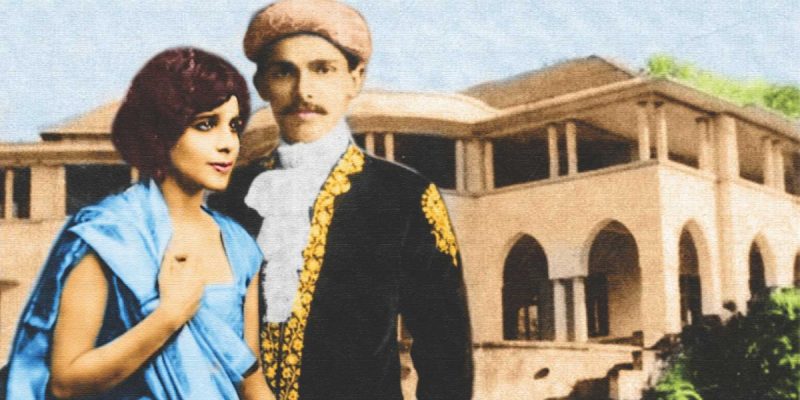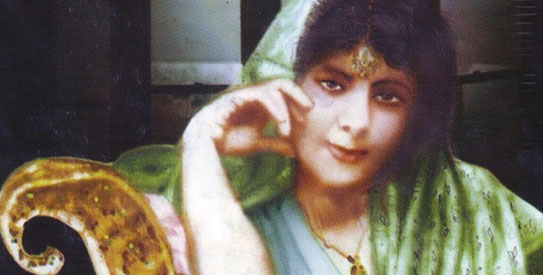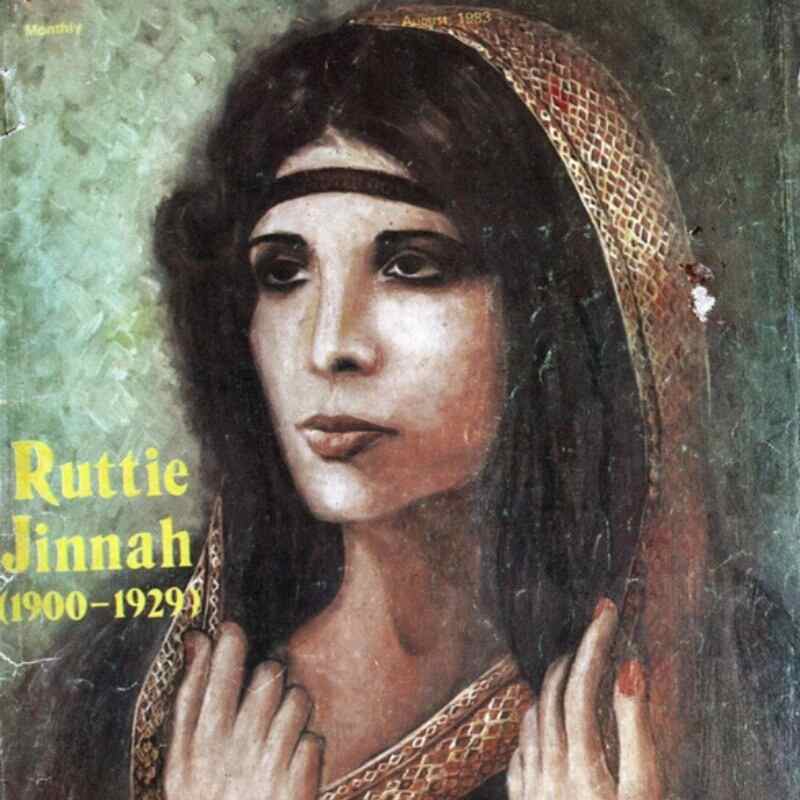Quaid e Azam Muhammad Ali Jinnah Ruttie Jinnah marriage more than a hundred years have passed but still this subject is an interesting subject for our historians and new revelations are constantly coming to light on this subject.
How Jinnah and Ruttie met and how their story reached marriage, we tell in detail in this article.
In the book of Pakistani Dr. Saad Khan in the private life of Quaid-e-Azam, some new aspects of this marriage have been revealed. He said that our marriage will be possible only when you accept Islam
First through his journalist friend Syed Abdullah Barelvi and then through his sister Shereen, he sent them some books about Islam Ruttan read these books and expressed his willingness to accept Islam
Sheila Reddy writes that in 1916, Jinnah went to Darjeeling with Ruttan Bai’s family.
Ruttan Bai’s father was one of the richest men in India
No one had any idea that Ruttan Bai would fall in love with Jinnah during this trip
Ruttan Bai had a different temperament from her childhood, she was brought up in a royal environment

At the age of 11, her father gifted her with Alfred Lutensim Dewan. When Ruttie met Jinnah, by that time she had studied Shelley Keats, Browning Burns, and countless other poets and many plays and novels. wherein she became romantically influenced by them
This was the atmosphere in which she met the prince of her dreams, the tall and handsome man she was attracted to.
Who was in a high position in the field of politics and law at that time?
In Darjeeling, Rati had the opportunity to closely examine the personality and political philosophy of Muhammad Ali Jinnah.
Ruttie Bai’s expression of love for Jinnah
Ruttie Bai, who was a strict prisoner of her ego and had been living a lonely life since her first marriage, found Ruttie Bai a unique person.
A man whose soul was very tender and delicate Muhammad Ali Jinnah and Ruttie Bai used to ride horses for hours in the green fields of Dajlang.
At the same time, they finally decided to support each other all their lives in the shadow of the beautiful scenery of nature
Among Ruttan Bai’s close friends was Roshni Naidu’s daughter Padma Jaa. Padma Jaa does not hide anything of her heart from Ruttan Bai, but despite being so close, there is no indication that Ruttan Bai has let her in on the biggest secret of her life.
When Jinnah returned from Dujlang, he became busy again in his political life but did not forget Ruttan Bai. The biggest problem for him was how to convince Ratanbai’s father of this marriage.
But he was one of India’s foremost lawyers. One day he reached Dinshopi’s house and, according to Sheila Reddy, he staked his friendship and Sir Dinshu’s peace of mind forever.
MC Chagla, a friend of Jinnah, has written in his book Roses in December Nato Biography that one evening after returning from Dujlang, Muhammad Ali Jinnah came to Sir Dinsho.
And after talking to and fro, they asked him what he thought about marriages between people of different sects.
Sir Petit, who was completely unaware of the situation, began to express his opinion very emphatically
When Jinnah asked Ruttie’s father for marriage, what was her father’s reaction?
He said that such marriages will increase national unity and solidarity and may eventually prove to be the final solution to communal hatred.
Jinnah could not have expected a better answer than this he bluntly told his friend without wasting any more words in the argument.
“I want to marry your daughter.”
Sir Dansho was left in awe. He had no idea what effect his opinion would have on himself. He was very angry.
They refused to even think about something fun to them

Sheela Reddy writes that it has never been definitively confirmed how genuine the conversation between the two was.
Neither Jannah ever confided in anyone, nor did Sir Dansho speak of it
Sir Dansho was a Parsi and this community in those days was particularly strongly opposed to its men and women marrying in other religions.
On the other hand, Ruttan Bai had also turned 17 years old and despite her father’s refusal, she did not stop meeting Jinnah, but she started meeting him openly.
Ruttan told her parents that she had decided to marry Muhammad Ali Jinnah
Sir Dansho and his Begum Lady Petit had hitherto regarded it as a one-sided affair with Muhammad Ali Jinnah.
Ruttan‘s irrevocable decision to marry Jinnah
Now, when they realized that both sides of the fire were equal, they first wanted to stop Ruttan by taking advantage of the age difference and then the difference in religion and customs.
But Ruttan’s decision was irrevocable, she had vowed that no power in the world could change her decision
Sheela Reddy writes that when one day in late June 1917 he suddenly reached the court to file a petition against Jinnah without consulting his Begum.
Taking cases to court was a bad habit sir dansho used to take small household disputes and business issues to court but to take court against Jinnah who had become a top lawyer in the country at that time was surprising and stupid.
The record of the court application has been lost, but Jinnah’s influence Sir Dansho claimed that Jinnah was planning to marry Rati without her father’s consent and that he had his eye on Rati’s wealth.
The court had assumed that the matter was not one-sided, but it was decided that Ruttie Bai could not marry off her own free will until 20 February 1918, i.e., until she turned 18.
Sir Dansho believed that Ruttan Bai’s passion for love would grow cold after being away from Jinnah for a year
But when they realized that it might not happen, according to Rizwan Ahmed, they started sending a message to Bala Bala Jinnah that if you are ready for civil marriage, then we can give Ashir later.
But this was against Jinnah’s mood. Jinnah was a Muslim and he also knew the law that for a civil marriage an oath must be taken that the parties do not belong to any religion.
Jinnah represented the Muslims in the Assembly and signing such an affidavit could have ruined his entire political career. On 20 February 1918, Ruttan turned 18 and was now free to make his own decisions.
He informed Jinnah of his decision that he was ready to become a Muslim
Dr. Saad Khan has written that the confusion before Jana was that since the Ismaili religion was declared Goodbye in 1909, he had no religious stamp.
Before 1918 he had married all three of his sisters for whom he did not care about the religious affiliation of his brothers-in-law’s families. That they are Shia, Sunni, or Ismaili
Muhammad Ali Jinnah was above all religious distinctions since 1901 but now had to choose one or the other religion to bring Ruttan Bai into the circle of Islam.
Jinnah’s struggle to bring Ruttan Bai into the Ismail sect
Muhammad Ali Jinnah, through his Ismaili friends Sir Muhammad Karim and Sir Fazl Bhai Karim bhai, contacted Lady Shams Ali Shah, mother of Sir Agha Soim, and asked how Ruttan Bai could be inducted into the Ismaili Jamaat.
Lady Shams Ali Shah was the spiritual patron of the Ismaili community. It was the same Ladies Shams who named Jana Muhammad Ali Jinnah when he was born 41 years ago.

So he apologized for allowing Ruttan Bai to join the Ismaili Jamaat
He said that his son Sultan Muhammad Shah is the Imam and his opinion on the matters of the Jamaat was final
Jinnah wrote a letter to Sir Agha Khan but displeased with Muhammad Ali Jinnah’s decision to reject the Ismaili faith 17 years ago, Sir Agha sent a reply in which he decided that Ruttan Bai should not join the Ismaili sect under any circumstances. cannot be allowed
According to Dr. Saad Khan, Jinnah Sahib considered Ruttan Bai’s acceptance of Islam under Ashri Shia.
He contacted the imam of Khawaja Hasan Ashri Jamaat mosque through his sister Maryam Pirbhai’s son-in-law Razi Ali Bhai Ibrahim Partliwala.
Probably the Shia leadership was also a victim of confusion, now the Jinnah, who was always above sectarianism, had no other option but to turn to the Sunni scholars.
Through his friend Umar Sabani, he formally contacted the Sunni religious scholar Maulana Nazir Ahmad for Ruttan Bai’s acceptance of Islam.
He accepted the request without any action. On 18th April 1918, Umar reached the house of Subhani Rutan Bai.
At that time, all his family members were out of the house in connection with the Parsi faith ceremony
Ruttan Bai converted to Islam and was named Maryam
Maulana Wazir Ahmed reached the mosque in the car of Ratan Bai Umar Sabani. This mosque was established by Maulana Khairuddin, the father of Maulana Abul Kalam.
Janas were also present there
Maulana taught Ratanbai the Kalma and named her Maryam, after which Umar Sobhani sent Ruttan Bai back to his home.
His family had not yet returned from the religious ceremony, so no one was aware of his absence for a few hours.
Dr. Saad Khan writes that when this news reached Khan Bahadur Seth Ali, the head of Khwaja Asna Ashri Jamaat in Mumbai, he sent an urgent message to Jinnah through Rajab Ali Ibrahim asking him to reconsider his previous decision and give him Ratan Bai. Khawaja is ready to join Asm Ashri Jamaat
Jinnah’s marriage ceremony
So the next morning Muhammad Ali Jana and Ruttan Bai Khawaja Asna joined the Ishre community
On Friday, 1918, Ratanbai and Quaid-e-Azam got married at the bungalow of Quaid-e-Azam Muhammad Ali Jinnah.
This Nikah was taught by Maulana Hasan Najvi according to Asna Shari’s beliefs
According to another tradition, this Nikah was performed by Mujtahid Shaikh Maulana Hasan Najafi of Bombay in his place on Prince Street. Qaida Azam’s brother Rajab Ali, brother Ibrahim, not only attended this marriage as a witness, he registered the marriage in the Pala Street mosque
According to this marriage certificate, the dowry amount was fixed at Rs 1000
While Muhammad Ali Jinnah presented his bride with Rs 125000.
Now that memorable moment has come when the groom was going to put a ring on the bride, it turned out that the groom forgot to buy the ring in his immense busyness.
In such a situation, Raja Sahib Mahmudabad came to Jinah’s aid and gave his diamond ring to Jinnah so that he could wear it on his bride.
The religion of Jinnah was written on the marriage certificate by Khwaja Asna Asri
Matter of partition of Jinnah’s property
After Jinnah’s death, when a dispute arose over the division of his property, the court could not decide what was Jinnah’s creed.
After the death of Jinnah, his property was given to Fatima Jinnah, but when Shiri Jinnah came to Pakistan after the death of Fatima Jinnah and adopted the Shia Twelver religion, some of Jinnah’s relatives once again tried to acquire his property. Contacted the court
According to Khalid Ahmad’s book Quaid-e-Azam’s Family Disputes, the decision of Jinnah’s sect has not been resolved yet
Wedding and Honeymoon of Jinnah and Ruttan
Jinnah chose the date of 19th April very thoughtfully, it was a Friday, and after that, the court was closed for two days, the day after the marriage, Jinnah went to Lucknow for a honeymoon with Ruttan Bai.

Where he stayed one day in the palatial house of Raja Sahib Mahmood Abad
Raja Muhammad Amir Ahmad Khan, the son of Maharaja Sir Muhammad Ali Muhammad Khan, used to tell this story often that when Jinnah Sahib came to Lucknow with his Begum after his marriage, I was very young at that time.
My father Majid was a friend of Mr. Jana Sahib who stayed with us in Lucknow for a few days with his Begum and then went to Nainital.
I still remember Rati Jana lovingly picking me up and sitting me on her lap, I kept looking at her face.
My eyes didn’t get away from his face
I felt as if one of the fairies I used to hear in the fairy tales at night had become a fairy. It has come down from the sky
Raja Amir Ahmad Khan also remembered that on this occasion Begum Ratibai Jinnah had taken out 100 rupees from her wallet as per custom.
Sheila Reddy writes in her book Mr. and Mrs. Jinnah that at breakfast Dansho Pettet opened his favorite newspaper.
I looked at the columns of the Mumbai Chronicle and page 8 and the tables were piled up. It was April 20, 1918, and Saturday.
Sheila Reddy writes that the Mumbai Chronicle had a few stories between two columns on the front page I, along with official and personal, was a phrase that was the subject of discussion in the drawing rooms and clubs of India for the next several weeks and months.
And this sentence was the marriage of respected MA Jinnah with Rati Petit last evening
What no one could understand till today was how Rati was missing from home for two consecutive days
First, on April 18, he went to Jama Masjid along with Jinnah and converted
Then the next evening on April 19, she escaped from her parents’ eyes and reached Jinnah’s bungalow on foot, where Jinnah and a Maulana and a dozen witnesses were waiting for her.
When Jinnah’s marriage became news
And then she disappeared for the whole night and no one knew that she was not in her bedroom
His parents came to know about his marriage in the morning from the news in the newspaper
In the next two or three days, this news was published in the Times of India, Statesman, Pioneer, and Civil and Military Gazette
On April 24, 1918, this news was also published as an editorial in the famous newspaper of Lahore
It was titled A Parsi Girl’s Acceptance of Islam. The news of Muhammad Ali Jana’s marriage spread like wildfire throughout India, especially in the Bombay Presidency, where the majority of Parsis lived.
Commentary on the news was widespread, Petit almost became homeless after the incident
Unwilling to discuss the matter with anyone, he was so angry that he decided to go to court again for his defeat.
He alleged that Jinnah had kidnapped his daughter to steal his wealth It was disgusting to me.
He had always boasted that he had become wealthy on his property
Now he was facing the accusation that he was a common man who had stolen wealth
Rati was also very angry at the court when the judge asked Jana if she had kidnapped Rati Petit from her father’s house before answering Jana, Rati stood up for her and said Your Excellency Mr. Jenna did not kidnap me I kidnapped him
Jinnah was also surprised by Ruttie’s fearlessness and that rare smile spread on his face which Rati cherished more than anything in the world.
Sir Dinsho Shah could never forget his daughter’s words and the expression on her face
The whole matter was over and all Rati had to do was sign the papers giving up her inheritance.
Death of Ruttie Bai
Ruttie Bai died on February 20, 1929. Hasan Alam M. Jafari has written in his book that on Ruttan Bai’s death, the Khawaja Shia Asna Shri Jamaat of Mumbai did not allow him to be buried in the Jamaat’s graveyard at Aram Bagh.
The Jamaat’s position was that no non-Khwaja could be buried in this cemetery
Jinnah challenged the Jamaat’s stand and said that he would go to court if they did not change their decision
In Jinnah’s words, Hussainbhai Lalji, president of the party, allowed Ruttan bai to be buried in the Aram Bagh graveyard.
Where they are also black dust
